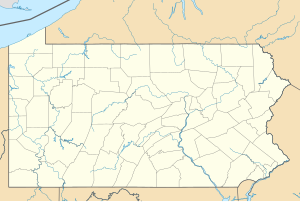Allegheny Aqueduct
Coordinates: 40 ° 26 ′ 54 ″ N , 79 ° 59 ′ 46 ″ W.
| Allegheny Aqueduct | ||
|---|---|---|
| use | Canal bridge | |
| Convicted | Pennsylvania Canal | |
| Crossing of | Allegheny River | |
| place | Pittsburgh , Pennsylvania | |
| construction | Suspension bridge | |
| overall length | approx. 300 m | |
| Longest span | 6 × 49.4 m | |
| building-costs | $ 58,297 | |
| start of building | August 1844 | |
| completion | May 1845 | |
| Status | tore off | |
| planner | John A. Roebling | |
| closure | 1861 | |
| location | ||
|
|
||
| Map of Pittsburgh 1855 | ||
The Allegheny Aqueduct was a canal bridge that led the Pennsylvania Canal across the Allegheny River into downtown Pittsburgh , Pennsylvania , USA . The Allegheny Aqueduct became known as the first suspension bridge built by John A. Roebling . It was also the first canal bridge designed as a suspension bridge.
The first Allegheny Aqueduct was a wooden bridge built in 1835 on the Pennsylvania Canal, over which the barges between Philadelphia and Pittsburgh could drive directly into the center of Pittsburgh. In the winter of 1844 this bridge was destroyed by ice drift.
In August 1844, John A. Roebling was awarded the contract to build a new canal bridge in the form of a suspension bridge according to his own plans and at a cost of $ 62,000. Until then, Roebling had made a name for himself as a manufacturer of wire ropes , but had never built a bridge. The 300 m long bridge trough, made of wood, was carried by parallel wire ropes that ran over seven brick pylons and were attached to the banks by means of chains and cast iron anchor plates in deep, brick anchor blocks. In May 1845 the trough was filled with water for the first time, after which the bridge was opened. According to Roebling's detailed records, the cost of the bridge was $ 58,297.
After the railway had expanded further and further from 1850 and also took over the routes of canals, the bridge was demolished in 1861.
literature
- JA Roebling: The Wire Suspension Aqueduct over the Allegheny River at Pittsburgh. In: Journal of the Franklin Institute. Ser. 3, No. 10, 1845, pp. 306-309.
- Donald L. Gibbon: How Roebling Did It: Building the World's First Wire-Rope Suspension Aqueduct in 1840s Pittsburgh in JOM, Vol. 58, No. 5, pp. 20-29; on TMS.org

